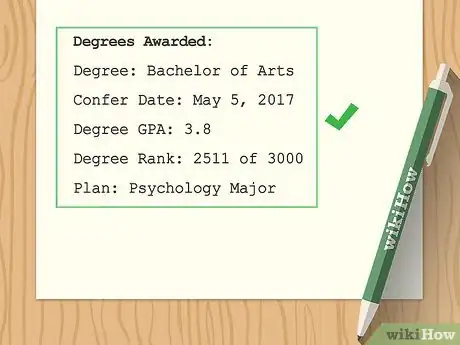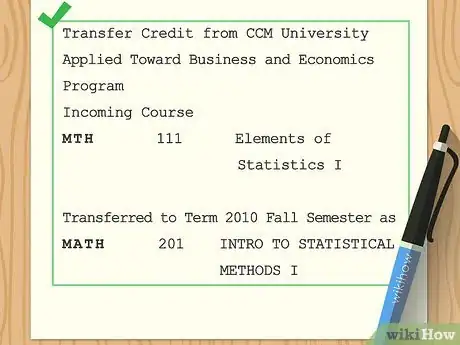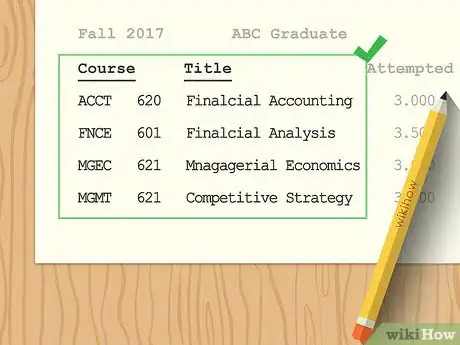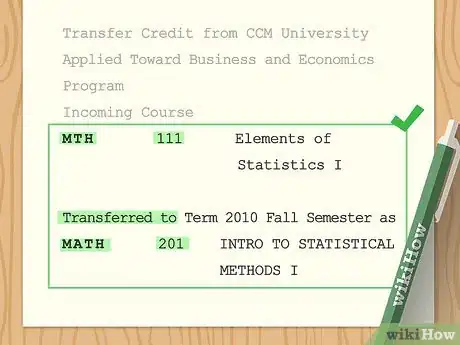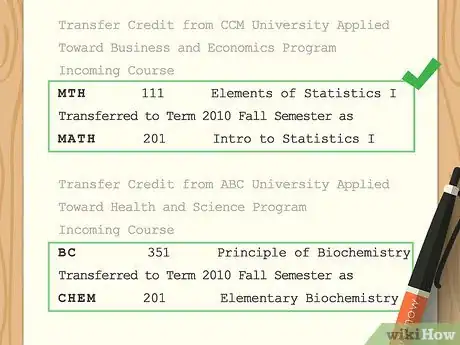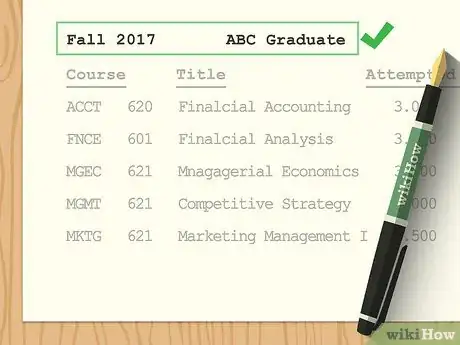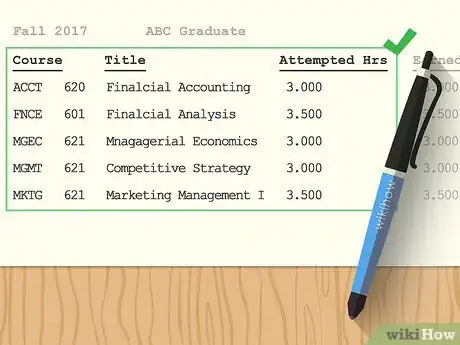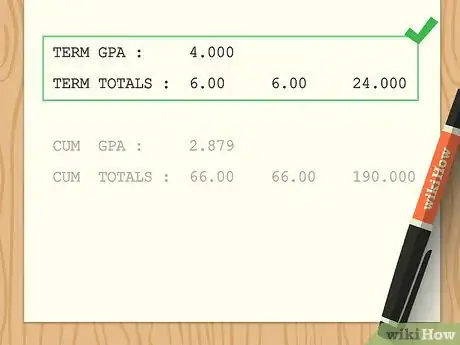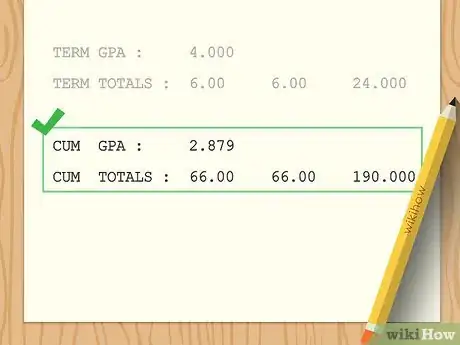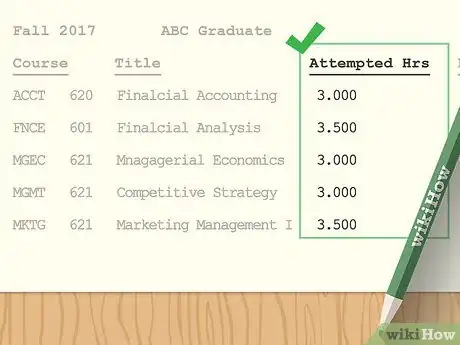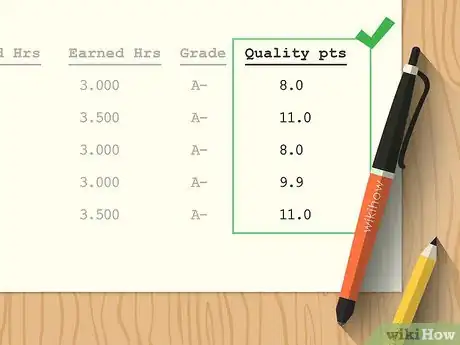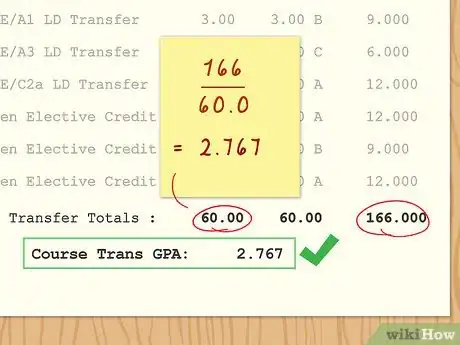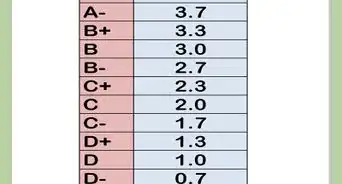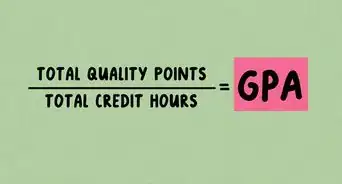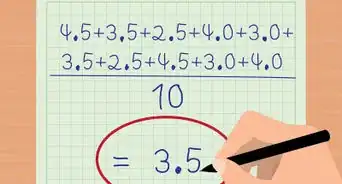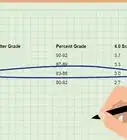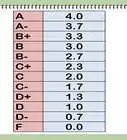This article was co-authored by Felipe Corredor. Felipe is a Senior College Admissions Consultant at American College Counselors with over seven years of experience. He specializes in helping clients from all around the world gain admission into America's top universities through private, one-on-one consulting. He helps guide clients through the entire college admissions process and perfect every aspect of their college applications. Felipe earned a Bachelor's Degree from the University of Chicago and recently received his MBA.
This article has been viewed 130,958 times.
Reading your unofficial transcript is a great way to get all of the details of your academic career without having to pay or wait for an official transcript. Your basic information, including any degrees awarded, is at the top of the transcript. The next section on your transcript will deal with any transfer credits, followed by your grades from the work you did at college. Understanding how your GPA is calculated can be a bit tricky, but as long as you know what numbers you're looking at, you can figure it out!
Steps
Reading Basic Transcript Information
-
1Check your admissions date. At the very top of your unofficial transcript, you'll see "Admissions date" or "Date of admission." This is the date that you were admitted or accepted into the university. It will sometimes be listed as only a month and a year, or it may be more specific, with the date, month, and year listed.[1]
- This date is usually a few months before you actually began taking classes. If you received a deferment on your admission, it might have been the previous semester or year.
-
2Look for the "date requested" listing. If you're requesting an unofficial transcript to submit for a job or school application, you need to make sure the requested date is listed. This way, when you submit the transcript as part of an application, whoever is reviewing it will see that it is the most recent transcript possible.Advertisement
-
3Confirm your college and major. If you've already declared a major, the top of your transcript should list which college you're enrolled in, as well as the major or majors you've declared. The semester or date you declared your majors should be listed next to them.[2]
- On some transcripts, you might see "programs" instead of "majors."
-
4Look for degrees awarded information. If you've already completed your degree, your transcript should list the degree or degrees you earned at that institution. They'll be listed in a section at the top of your transcript under "Degrees Awarded."
- In order, the "Degrees Awarded" section usually lists the degree you earned, the date you earned it, and your majors and minors.
- For example, in successive lines you might see "Bachelor of Arts," "May 5, 2017," "Psychology," and "History," each on their own line.
Understanding Your Transferred Credits
-
1Look at the breakdown of transfer credits. Your transfer credits will list any courses you took at another institution, credits you earned from testing, or credits for AP courses you took in high school. Your transfer credits will be arranged by type, so all of the credits you earned at other schools will be listed together.
- If you're transferring in credits from more than 1 school, those credits will be listed by school.
- Some schools don't list each course individually. Instead, they might just list the total number of credits that transferred from each category.
-
2Read each course's information horizontally across the page. Under each transfer section, you'll see a list of the courses that transferred over. Find the first course that transferred, and follow the line horizontally across the page. A number will be listed to the right of the course that indicates how many credits from that course transferred to your new school.
- For example, the first course listed might be "Hist 101." To the right of the course number, you might see the number 3. That tells you that you transferred 3 credits from Hist 101 to your new school.
-
3Check the equivalent coursework listing for transfer credits. Under each transferred course, your transcript will then list the equivalent coursework at your current institution. These equivalency courses are usually listed by the course type and number. In general, they should be the same course type as the credits you're transferring in.
- For example, if you're transferring in a biology class from your last school, or an AP Bio score from high school, the equivalency course will generally look something like "Bio 143."
-
4Make sure all of the available credits transferred. Under your list of transferred courses, you'll see a number. This is the total number of credits you're trying to transfer. Under that number, you might see a section titled "Transfer credit adjustment," with a negative number. That number is the number of credits that didn't transfer. Under that number you should see a number that says "Credits transferred." That number will be your total attempted transfer credits minus the transfer credit adjustment.
- Most schools only allow you to transfer over a certain number of credits from other institutions, testing, and AP credits. That's why a transfer credit adjustment is necessary.
Reading Your Undergraduate Record
-
1Look for the semester and year. After the transfer section, you'll see that your undergraduate record is divided into semesters. In the center of the page, you should see the semester and year for the first semester you took courses at this institution.[3]
- For example, under your transfer section, you might see "Fall 2010" at the top center of the page. This should be the first semester you took courses as this institution.
-
2Read your transcript horizontally by class. Under the semester designation, you should see a list of course numbers. Read across the page horizontally. You will find all of the information for each course listed on this horizontal line.[4]
- The course number tells you how the course appears in the catalog. For example, one of your history courses might be listed as "Hist 101".
- The next column is usually the title of the course. This is your class's actual name. Hist 101, for example, might be titled "Intro to World History."
- Next you should see the attempted hours/credits for that course. This is the total number of credit hours for the course (usually 3 or 4). Next to the attempted hours, you'll see earned hours. As long as you passed the class, this number should be the same as credits attempted.
- Next you'll see your letter grade for the course. This is usually a letter between A and F, with pluses and minuses possible for each letter grade.
- Finally, you'll see a number listed as either "quality hours" or "quality points." This number will help you calculate your GPA.
-
3Check each semester's GPA. At the bottom of each semester's section, under the list of the courses you took, you'll see your semester GPA. It might be listed as "term GPA," or "semester GPA." Reading that line horizontally will tell you what GPA you earned, and how many credit hours you attempted and earned that semester.[5]
-
4Look for your cumulative GPA on the last page of your transcript. At the very bottom of your transcript, you should see a section titled "Undergraduate Career Totals." In this section you can see your overall GPA and how many credit hours you attempted and earned over your entire undergraduate career.[6]
Understanding Your GPA
-
1Look for your attempted credits. You can look for this in an individual semester's section, or at the end of your transcript for your entire undergraduate career. It should be on the last line and is usually listed as "Units attempted," "credits attempted," or "hours attempted."
-
2Check for the "Quality Hours attempted" section. The final column for each course should be "quality hours" or "quality points." These are calculated by taking the credit hours of a course and multiplying it by the numerical value of the grade you earned in that course. This weights your grade in order to help calculate your GPA.
- Schools may have different weights for letter grades, but in general, an A is worth 4 quality hours, a B is worth 3 quality points, a C is worth 2, and a D is worth 1. Es and Fs are not worth any points.
- So for example, say you took Hist 101, which was 3 credits hours, and you earned an A. You would multiply the 3 credit hours of the course by the 4 quality hours your A is worth to get 12 quality points for that class.
-
3Look for the quality hours or points total. At the bottom of the section under the "quality hours" or "quality points" column, you should see another number. This is the sum of all of the quality hours or points you earned during the semester or over your undergraduate career. If you add up the quality hours or points earned for each course, you should get this number.
- If you're checking your quality hours or points for one semester, this number will be near the end of the section. If you're checking for your entire career, it will be at the end of your transcript.
-
4Divide the quality hours earned by your attempted credits. Once you divide your credits into your quality hours, you'll get your GPA. This takes into account all of the courses you took, whether you passed, and how well you did.
- The attempted credits number is usually to the left of the quality hours earned number.
- If, for example, you attempted 12 credits in one semester, and earned 48 quality hours, you'd divide 48 by 12 to get 4. Your semester GPA is therefore a 4.0.
Community Q&A
-
QuestionWhat is a unofficial transcript?
 Drew Hawkins1Community AnswerAn unofficial transcript is a record of your college career printed on plain paper without a college seal or your registrar's signature. That means they usually won't be accepted for official purposes such as when you apply to graduate school. However, they can provide valuable information that you can use. It's a great way to get all of the details of your academic career without having to pay or wait for a full, official transcript. It includes your basic info, your degrees, and the grades for all of the work you did while you attended college.
Drew Hawkins1Community AnswerAn unofficial transcript is a record of your college career printed on plain paper without a college seal or your registrar's signature. That means they usually won't be accepted for official purposes such as when you apply to graduate school. However, they can provide valuable information that you can use. It's a great way to get all of the details of your academic career without having to pay or wait for a full, official transcript. It includes your basic info, your degrees, and the grades for all of the work you did while you attended college. -
QuestionHow do I read my unofficial transcript?
 Drew Hawkins1Community AnswerIt's actually not as tricky as it looks. At the top, you'll find your basic info such as your name and the dates you attended the school. If you've already completed your degree, your transcript should list the degree or degrees you earned at that institution. They'll be listed in a section at the top of your transcript under "Degrees Awarded." The next section will deal with transfer credits if you transferred schools at any point. After the transfer section, you'll see that your undergraduate record is divided into semesters. In the center of the page, you should see the semester and year for the first semester you took courses at the school. Read across the page horizontally and you'll see all of the information for each course listed on the horizontal line.
Drew Hawkins1Community AnswerIt's actually not as tricky as it looks. At the top, you'll find your basic info such as your name and the dates you attended the school. If you've already completed your degree, your transcript should list the degree or degrees you earned at that institution. They'll be listed in a section at the top of your transcript under "Degrees Awarded." The next section will deal with transfer credits if you transferred schools at any point. After the transfer section, you'll see that your undergraduate record is divided into semesters. In the center of the page, you should see the semester and year for the first semester you took courses at the school. Read across the page horizontally and you'll see all of the information for each course listed on the horizontal line. -
QuestionDo colleges accept unofficial transcripts?
 Drew Hawkins1Community AnswerSometimes they do. Some graduate programs may ask you to submit an unofficial transcript as you start the application process. This can give them a general idea of what your undergraduate career looked like. However, most schools will require you to submit an official transcript in order to apply there. Usually, you'll contact the school you attended for your undergrad and ask the registrar's office to submit a signed and sealed transcript to the school you're applying to attend. They'll mail your official transcript on your behalf. It can take a few days or weeks for your official transcript to arrive, so don't wait until the last minute!
Drew Hawkins1Community AnswerSometimes they do. Some graduate programs may ask you to submit an unofficial transcript as you start the application process. This can give them a general idea of what your undergraduate career looked like. However, most schools will require you to submit an official transcript in order to apply there. Usually, you'll contact the school you attended for your undergrad and ask the registrar's office to submit a signed and sealed transcript to the school you're applying to attend. They'll mail your official transcript on your behalf. It can take a few days or weeks for your official transcript to arrive, so don't wait until the last minute!
Expert Interview
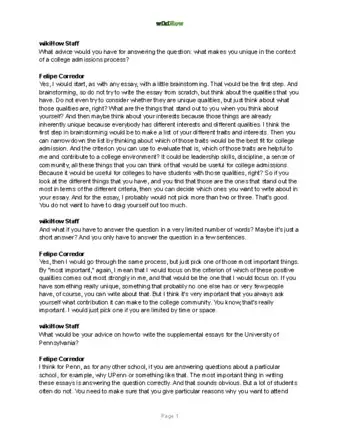
Thanks for reading our article! If you'd like to learn more about unofficial transcripts, check out our in-depth interview with Felipe Corredor.
References
- ↑ https://kb.wisc.edu/registrar/page.php?id=96537
- ↑ https://kb.wisc.edu/registrar/page.php?id=96537
- ↑ https://uwaterloo.ca/registrar/transcripts/understanding-your-unofficial-transcript
- ↑ https://uwaterloo.ca/registrar/transcripts/understanding-your-unofficial-transcript
- ↑ https://uwaterloo.ca/registrar/transcripts/understanding-your-unofficial-transcript
- ↑ https://uwaterloo.ca/registrar/transcripts/understanding-your-unofficial-transcript
About This Article
An unofficial transcript is useful for seeing the credits you’ve earned as well as the grades you made in all of your courses. Look a the top of the transcript to find basic information like your major, your final GPA, and the degree you were awarded if you’ve already graduated. In the next section, you’ll see any transfer credits if you took courses at a different institution. After this, look for your course list, which should list several things. On the far left column, you’ll see the name of the course. Next to that, you’ll see the number of credits the course is worth. You’ll also see your attempted hours for that course. If the credits and attempted hours columns are the same, you passed the class. You’ll then see your letter grade and finally, your GPA for the course. To learn how to calculate your GPA, read on!



